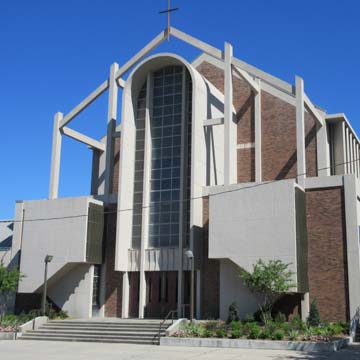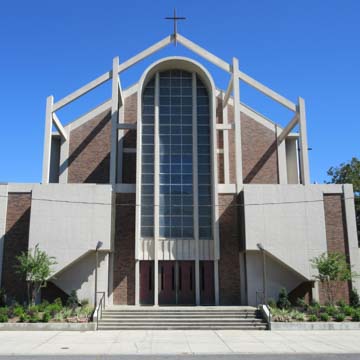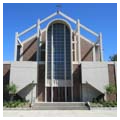Asked to design a large and important church for this congregation to replace a smaller building, Lamantia produced a contemporary interpretation of the traditional basilica form, one he described as the most baroque of all his compositions. The reinforced-concrete frame is pulled to the church’s exterior, revealing and clarifying the logic of the structure while creating a dramatic play of vertical and diagonal lines. At the east and west ends, stained glass windows are recessed into vaultlike spaces to provide a contrasting dynamic to the angularity of the external frame and to give a hint of the space within. Placement of the choir stairs on the exterior, at each side of the entrance, adds another sculptural note and allows more interior space by reducing the size of the narthex. Vertical precast concrete louvers alternate with stained glass windows (featuring stylized biblical figures in primary colors) along the clerestory; the lower walls are of beige brick. The interior is impressively lofty. The rectangular concrete piers that separate the tall, wide nave from the narrow aisles echo the external frame, as do the laminated wooden arches that form the ceiling. A freestanding circular baptistery (now occupied by offices) is crowned by a tall openwork bell tower that responds to the skeletonlike frame of the church, to which it is connected by a covered walk. The church’s facade faces the street, whereas the baptistery was intended to be seen from Metairie Road.
You are here
St. Catherine of Siena Roman Catholic Church
If SAH Archipedia has been useful to you, please consider supporting it.
SAH Archipedia tells the story of the United States through its buildings, landscapes, and cities. This freely available resource empowers the public with authoritative knowledge that deepens their understanding and appreciation of the built environment. But the Society of Architectural Historians, which created SAH Archipedia with University of Virginia Press, needs your support to maintain the high-caliber research, writing, photography, cartography, editing, design, and programming that make SAH Archipedia a trusted online resource available to all who value the history of place, heritage tourism, and learning.





